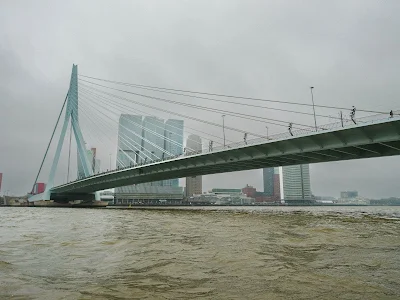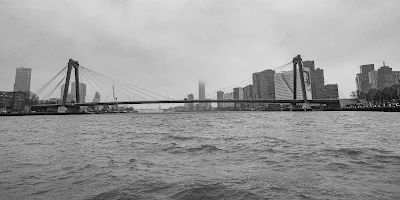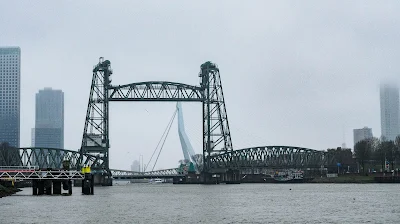It was a cold, dull day, and the light was not the best for taking photographs, but it was good to walk and listen and see the Lapwings, Gadwells, Wigeons, and Goldeneyes in the distance. The Kestral was busy hunting but the light made it difficult to capture an image.
Wednesday, 25 December 2024
Christmas Day - Wicken Fen
Wednesday, 18 December 2024
The Fonske, Leuven
His full name is Fons Sapientiae, Latin for Source of Wisdom. The Fonske is one of Jef Claerhout's works and was donated to the city in 1975 on the occasion of the 550th anniversary of the Catholic University of Leuven.
The statue represents a student who, reading a book, lets wisdom flow through his head in the form of water. But this explanation would have been given to the statue later. According to sculptor Claerhout: "It is a sculpture of someone who, pouring a beer into his cup, studies his behaviour". Student organizations did not agree with this and found it to be a caricature of the drinking student. That is why the statue was renamed "Source of Wisdom"
Saturday, 14 December 2024
Rotterdam
- The settlement of Rotta, dating back to the 9th century, was abandoned in the 12th century due to flooding. Around 1270, a dam was built at Hoogstraat, giving the city its name.
- Rotterdam gained city rights from Count Willem IV of Holland on 7 June 1340. Defensive walls were gradually added, culminating in a stone wall completed by the 16th century.
- During the Hook and Cod Wars (1488–1490), Jonker Frans van Brederode used Rotterdam as a base, significantly boosting its status.
- The late Gothic St. Lawrence Church, built between 1449 and 1525, was the city’s first and only stone building during the Middle Ages.
Friday, 13 December 2024
Veune, Belgium
Veurne, first mentioned as Furnu in 877, likely developed around one of the castles built by the Count of Flanders in the late 9th century to defend against Viking invasions. In the 10th century, the Vikings attacked the settlement, prompting the expansion of the (round) castle. The mound in Sint-Walburgapark is a remnant of this fortification, which also explains the circular layout of Veurne's streets.
Around 870, the relics of Saint Walburga were brought to Veurne, enhancing its spiritual significance. Later, in the early 12th century, Count Robert II of Jerusalem donated a relic of the Holy Cross to the town. By 1060, a trading settlement had formed to the castle's east, while a craft centre developed to the south near the now-lost Saint Denis Church. Veurne also maintained connections to the hinterland, including Sint-Winoksbergen, via the Kolme or Bergenvaart waterway.
The town hall is an impressive Renaissance-style structure built of brick, comprising two adjoining wings with distinctive gables. The left wing, featuring four bays, was constructed in 1596, while the right wing, with five bays, was completed in 1612. The rear facade, dating back to 1599, adds further architectural interest. The design of the building is attributed to Lieven Lucas, with the facade credited to Jerom Stalpaert and Ferri Aerts.
The facade showcases a striking balcony, supported by Ionic columns set under basket-handle arches. At the centre of the balcony, the coat of arms of the castellany is prominently displayed. Adding to its charm, an octagonal turret enhances the rear facade.
On the right side of the complex, a passage leads to the Landshuis, positioned at a right angle to the town hall.
In 1939, a Neo-Renaissance-style extension was added to the left of the town hall, designed by Camille Van Elslande, blending seamlessly with the historic structure.
Saturday, 19 October 2024
Berwick Church - St Michael & All Angels Church Sussex
Berwick Church, East Sussex is famous for its Bloomsbury paintings by the artists Duncan Grant, Vanessa Bell and Quentin Bell. St Michael and All Angels is a Grade 1 listed building. Although it may well have Saxon or Norman origins, it was heavily restored in 1856 to designs by local Victorian architect Henry Woodyer. The 20th Century Bloomsbury Murals attract about 10,000 visitors each year.
Berwick (pronounced /ˈbɜːrwɪk/ BUR-wik or, more recently, /ˈbɛrɪk/ BERR-ik) is a picturesque village and civil parish in the Wealden district of East Sussex, England. Situated just south of the A27 road between Lewes and Polegate, the village is about three miles (4.8 km) west of Polegate. The parish is set in the River Cuckmere's floodplain and lies north of the scenic South Downs.
In 1941, during the Second World War, Bishop Bell of Chichester commissioned the Bloomsbury artists Duncan Grant, Vanessa Bell and her son Quentin Bell, to decorate the interior of the small rural church of St Michael & All Angels, Berwick.
Julian Bell, the grandson of Vanessa Bell, was commissioned to make a reredos painting for the church and this was installed in early 2020. Julian has written a short pamphlet about the process of the commission and the painting which is available in the church or download The Way – The Pilgrim Painting by Julian Bell. One can watch a YouTube recording of Talking to Julian Bell.
Etymology and History
The name "Berwick" was first recorded in the Domesday Book of 1086 as Berewice. Its origins lie in Old English, meaning "corn farm," indicative of its agricultural history.
Key Features
Public Houses: The parish boasts two traditional public houses:
The Berwick Inn, is conveniently located near the village's railway station.
The Cricketers, situated in the village's heart, offers a quintessential village pub experience. It is very popular and a delightful place to have lunch.
Iconic Red Telephone Box: Berwick features a classic "K6" red telephone box, a symbol of British heritage, adding to the village's charm.
Berwick's combination of historical significance and setting in the picturesque Sussex countryside makes it a notable location for visitors and locals.
























































